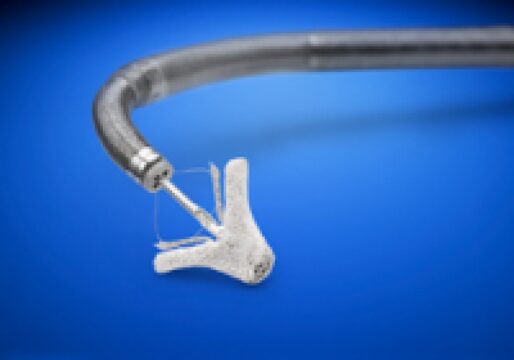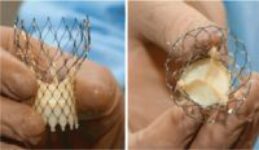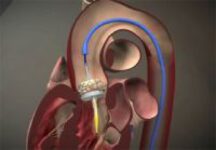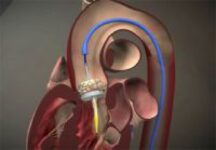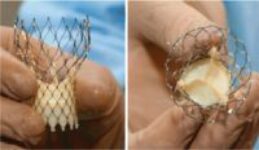Original title: Acute outcomes after MitraClip® therapy in highly aged patients: results from the German TRAnscatheter Mitral valve Interventions (TRAMI) Registry. Reference: Wolfgang Schillinger et al. EuroIntervention 2013; 8-online publish-ahead-of-print April 2013. Recently, percutaneous repair of the mitral valve with MitraClip®, (Abbott Vascular, Santa Clara, CA, USA), has emerged as an option for patients with severe mitral regurgitation,…
The need for pacemaker post TAVI does not change the prognosis
Original title: Impact of Permanent Pacemaker Implantation on Clinical Outcome Among Patients Undergoing Transcatheter Aortic Valve Implantation. Reference: Lutz Buellesfeld et al. J Am Coll Cardiol 2012;60:493–501 Although pacemaker implantation after a percutaneous aortic valve (TAVI) implantation, constitutes a significant proportion of the complications related to the procedure, this is generally considered a benign event. This study analyzed…
CoreValve versus Edwards. Equivalent results at one year
Original title: Transcatheter Aortic Valve Implantation With the Edwards SAPIEN Versus the Medtronic CoreValve Revalving System Devices. A Multicenter Collaborative Study: The PRAGMATIC Plus Initiative (Pooled-RotterdAm-Milano-Toulouse In Collaboration). Reference: Alaide Chieffo et al. J Am Coll Cardiol 2013;61:830–6. Since the introduction of percutaneous aortic valve replacement (TAVR), two devices have been widely used. For one side, the self-expanding…
Severe Mitral Insufficiency Following Mitral Valvotomy
Original title: Acute Severe Mitral Regurgitation Following Balloon Mitral Valvulotomy: Echocardiographic Feature, Operative Finfing and Outcome in 50 Surgical Cases. Reference: Manjunath C. Nanjappa, et al. Catherization and Cardiovascular Intervention 81:603-608 (2013) Severe Mitral Insufficiency Following Mitral Valvotomy (VPM) is a major complication; though not frequent, (0.9%-2%) it is life threatening and requires resolution through valve replacement. The…
Mitraclip® year results
Original title: Residual Mitral Valve Regurgitation After Percutaneous Mitral Valve Repair with Mitraclip® System in a Risk Factor of Adverse one-Year Outcome Reference: Liliya Paranskaya et al. Catheterization and Cardiovascular Intervention 81:609-617 (2013). Currently, the gold standard for the treatment of mitral regurgitation (MR) is surgery but 20% of patients are rejected because they present a high surgical…
TAVI also for pure aortic insufficiency
Original title: Transcatheter Aortic Valve Implantation for Pure Severe Native Aortic Valve Regurgitation. Reference: David A. Roy et al. J Am Coll Cardiol 2013. Article in press. Percutaneous aortic valve replacement (TAVI) has become a standard treatment for patients with severe aortic stenosis and a high surgical risk. However for those patients who have pure aortic insufficiency, (failure…
Favorable outcomes at 5 years post TAVI.
Original title: 5-Year Outcome After Aortic Valve Implantation Reference: Stefan Toggweiler, et al. J Am Coll Cardiol 2013;61:413–9 Percutaneous aortic valve implantation (TAVI) is now a valid strategy as we know its short and medium term evolution but we do not have enough information available about the long term. The aim of this study was to analyze the…
TAVI and cardiac tamponade, a rare but serious complication.
Original title: Incidence, Management and Outcomes of Cardiac Tamponade During Transcatheter Aortic Valve Implantation Reference: Ahmed Rezq et al. J Am Coll Cardiol Intv 2012;5:1264 –72 Transcatheter Aortic Valve Implantation (TAVI) for high risk patients is a valid strategy today but not without complications. Among these is cardiac tamponade, still rare but important because of its implication. There…
Post TAVI LVEF Improvement: Only with No New Conduction Defects
Original title: Impact of a New Conduction Defect Alter Transcatheter Aortic Valve Implantation on Left Ventricular Function Reference: Rainer Hoffmann, et al. J Am Coll Cardiol Intv 2012;5:1257– 63. TAVI development in high risk patients can produce new conduction defects and require a definitive pacemaker in almost a third of treated patients. The aim of this study was…
Transfemoral Transcatheter Aortic Valve Implantation: more experience and better results.
Original title: Trends in outcome after transfemoral transcatheter aortic valve implantation. Pooled-RotterdAm-Milano-Toulouse In Collaboration Plus (PRAGMATICPlus) initiative. Reference: Nicolas M. Van Mieghem et al. Am Heart J 2012;0:1-10. Article in press. Since its introduction in 2002, Transfemoral Transcatheter Aortic Valve Implantation (TAVI) has turned into a viable and safe strategy to treat patients with severe acute stenosis and…
Aortic insufficiency has a poor prognosis in TAVI.
Original title: Impact of Post-Procedural Aortic Regurgitation on Mortality Alter Trancatheter Aortic Valve Implantation Reference: Kentaro Hayashida, et al. J Am Coll Interv 2012;5:1247-56 Transcatheter aortic valve implantation (TAVI) sprung up as a valid strategy to treat patients with severe high risk AS (aortic stenosis). However, residual aortic regurgitation (post AR) and post-dilation remain unsolved. Between October 2006…
